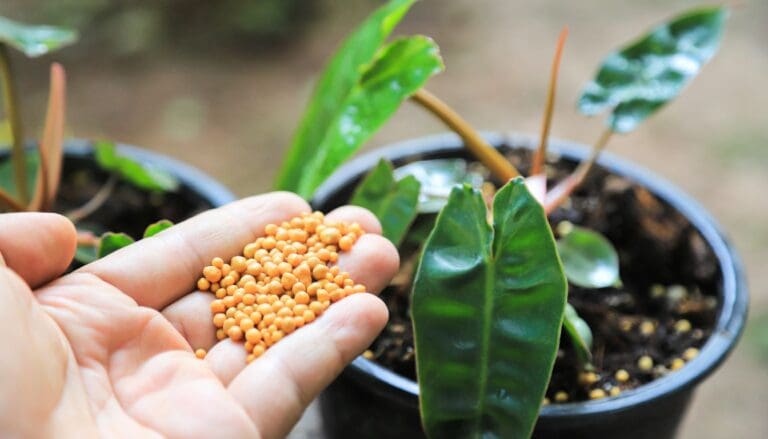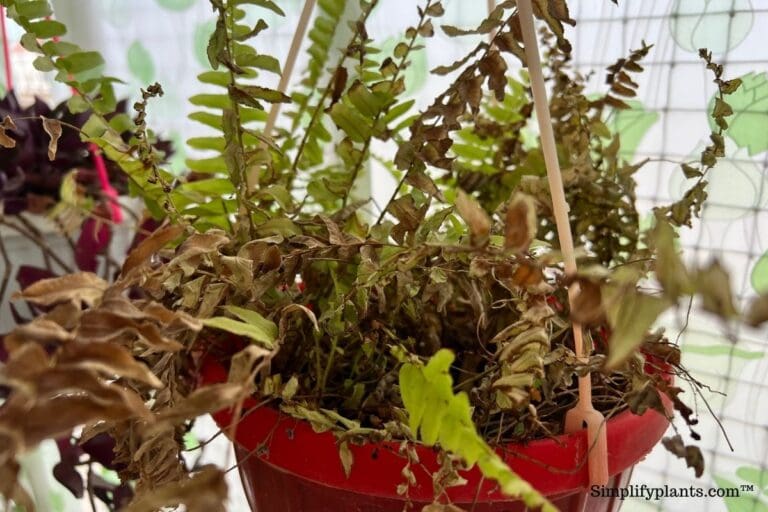Does Monstera Attract Bugs? (How To Get Rid Of Them)
Monsteras are hardy plants that don’t attract bugs if you take good care of them. But will the Monsteras get attracted by bugs? Let’s see.
Excess moisture, wet leaves, or over-fertilizing your Monstera can attract bugs such as aphids, spider mites, mealybugs, thrips, and gnats. Use neem oil or insecticidal soap to eliminate them. Chemical pesticides are needed for severe infestations.
I’ve gardened for 12 years and saved my Monsteras from infestations multiple times. Stick till the end to understand infestation reasons, pests, treatment, and prevention.
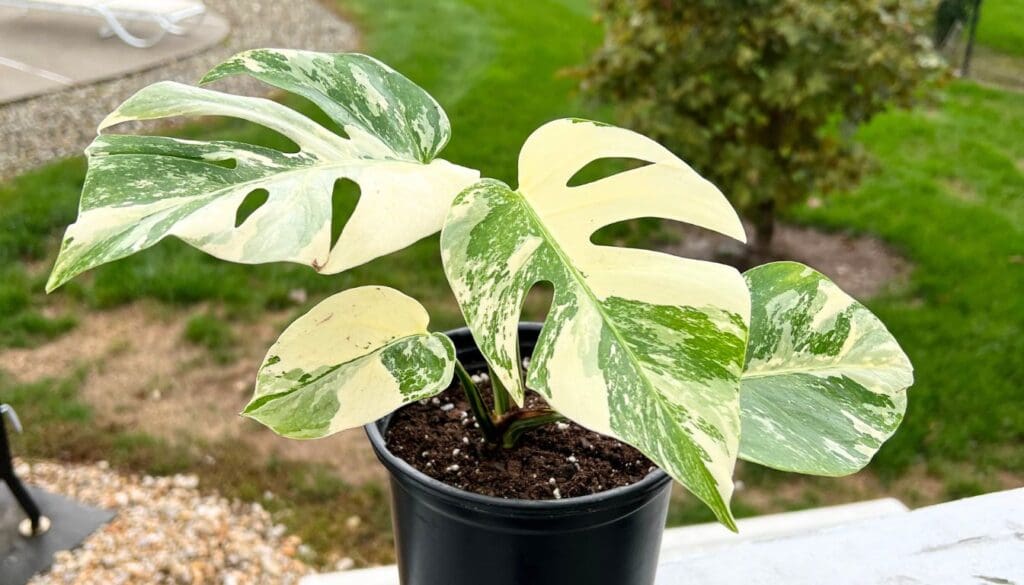
Please note: Simplify Plants is reader-supported. Some links in the post are affiliate links and I get a commission from purchases made through links in the post.
Excessive moisture levels can attract bugs in Monstera plants
Maximum bugs love moisture, and prolonged moisture levels are the main reason behind bug infestation.
In overwatering or poor drainage, water retains in the soil for long.
If you don’t let your soil dry before watering, gradually aphids, spider mites, mealybugs, or gnats will reside in the plant.
Bone-dry soil attracts Monstera pests
Another condition where bugs get attracted by Monsteras is when you do not water your plants at all.
Excessive dry conditions for a very long time slowly result in yellowing, stunted growth, and defoliation.
Over time, the plant will weaken, and pests will make it their home.
Over-fertilization can cause bug infestation in Monsteras
Monsteras thrive with fertilization, but excessive feeding is not advisable.
Excessive fertilization can burn the roots and encourage weak and spindly growth in the Monsteras.
Overfertilization thus only makes your plant weak, and weak plants are more susceptible to pests.
High humidity with poor airflow invites pests in Monstera
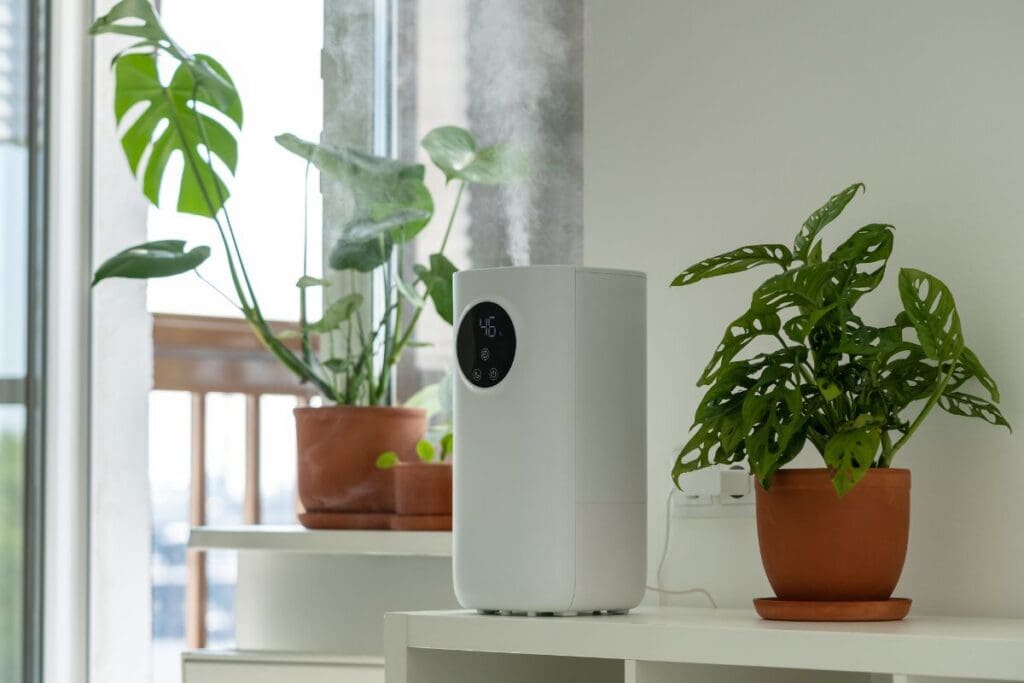
Excessive humidity levels can also attract bugs because it encourages high moisture in the air.
And, as I said, most bugs love moist conditions.
Your Monstera becomes more susceptible to pests when no airflow is around to dry out the moisture.
Such conditions are not only perfect for pests, but also for fungal diseases.
Understanding the signs of bug infestation in Monstera plants
How can you tell if pests have infested your Monsteras? Here are some telltale signs of Monstera bug infestation:
- Yellow leaves
- Brown spots on the leaves and stems
- Sticky residue and black sooty mold
- Leaves are deformed
- Stunted growth despite proper cultural practices
- Holes in the leaves
- Squiggly lines on the leaf surfaces
- Web-like structures on the leaves
- White or black powdery substances
- Aerial roots turning brown or black
These are the common signs of infestations.
But how will you understand which pests have attacked your Monsteras?
You will need to observe your plant closely and look for the pests.
Observing their physical characteristics will help you identify which bug has infested your plants.
Sometimes, some specific signs are shown by specific pests. Keep reading to learn more.
8 common bugs in Monstera and how to deal with them
I still receive messages from readers asking about common Monstera pests and how to handle them.
Occasionally, my readers request me to offer solutions for each pest separately.
The general troubleshooting guide applies to most pests, but if you still need it, in this section, I will share the common bugs and treatments for each of them:
1. Troubleshooting Aphid Infestation in Monsteras
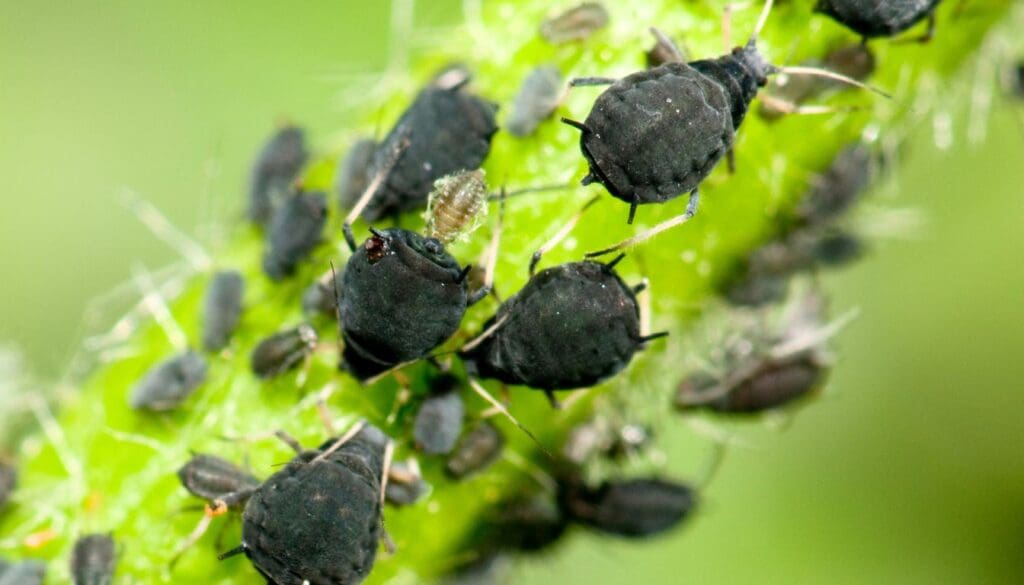
Aphids are primarily found in the new Monstera leaves as they are young and soft to pierce for sucking the plant sap.
They love moist conditions.
Aphids are tiny and can be white, green, yellow, red, brown, or black.
After feeding on the plant sap, they excrete honeydew, making the leaves sticky.
Over time, the stickiness attracts black mold.
Common signs of infestation are:
- Wilted and yellow leaves
- Curly and deformed leaves
- Sticky leaves due to honeydew excretion
- Black sooty mold
To troubleshoot an aphid infestation in Monstera:
- Shower your Monstera to dislodge the bugs from their place.
- Release beneficial insects like ladybugs (1500 Live Ladybugs – Good Bugs – Ladybugs – Guaranteed Live Delivery!) or lacewings for biological control of the pests. They feed and kill the pests without harming the plant.
- Use neem oil (Neem Bliss – Pure Neem Oil for Plants – Organic Neem Oil Spray for Plants, 100% Cold Pressed Neem Oil – OMRI Listed Pure Neem Oil – All-Natural Neem Oil Concentrate Leaf Polish For Plants (16 Fl Oz)) or insecticidal soaps to get rid of them.
- If the infestation seems enormous, try chemical pest control with pesticides containing pyrethrins or imidacloprid.
2. Eradicating Mealybugs from Monstera

Mealybugs, another sap-sucking bug, have a white cottony appearance, making it easier to identify them in the Monstera leaf joints and stems.
They attack your Monsteras when the soil stays wet for a long time.
Common signs of mealybug infestation are:
- White cottony substance moving on the leaves
- Sticky leaves due to honeydew
- Black sooty mold on the leaves
- Ants roaming around the sticky leaves
- Yellow leaves
Once you have confirmed the issue, it’s time to eradicate them:
- Quarantine your plant from the other plants to prevent spreading.
- Spray some neem oil on the infected areas, especially on the stems and underside of the leaves.
- Alternatively, wipe the infested stems and leaves with a cotton ball dipped in 70% rubbing alcohol (Isopropyl Alcohol 99% (IPA) Made in USA – USP-NF Grade – 99 Percent Concentrated Rubbing Alcohol (1 Liter)).
- If the infestation is massive, use pesticides with imidacloprid and pyrethrins.
3. Killing Spider Mites in the Monstera plants

The next sap-sucking bug is Spider mites (primarily red and black).
It attacks the Monstera plants when the surrounding temperature is warm and dry.
Common signs of spider mite infestation are:
- Webbings on the leaves
- Small black or red moving dots under the leaves and stems
- Droopy or curled leaves due to dehydration
For confirmation, keep a white paper under the plant and shake it.
As they fall off, you will see them moving around.
Here’s what you need to do to kill spider mites from Monsteras:
- Put your Monstera into a shower to dislodge them.
- Wipe the leaves with 70% rubbing alcohol or any commercial or DIY horticultural soap.
- Spray neem oil.
- Release natural predators like ladybugs or predatory mites (2,000 Live Adult Predatory Mites Packed in a 16 oz Container – P. persimilis a Predatory Mite Species for Spider Mite Control – Ships Next Business Day!) to feed on the spider mites.
Mix 1 cup of oil with 1 tbsp of dishwashing liquid or Castile soap to make horticultural soap.
Dilute the soap mixture with warm water by adding 2 tsp for every cup of water.
Avoid using soaps containing bleaching products, as that will hurt your Monsteras.
You may add some cayenne pepper or garlic powder as an additional ingredient to keep the pests from feeding on your plant in the future.
Do not use this solution during hot weather, especially when the temperatures are over 85°F or under direct sunlight.
If you need a commercial one that saves your time, try Monterey Horticultural Oil – Organic Gardening Fungicide, Insecticide, & Miticide – 1 Quart – Apply Using a Sprayer Following Mix Instructions
4. Dealing with Thrips in Monstera

Thrips are difficult to notice in the Monsteras because of their tiny size.
They also drain the vital sap from the plant leaves and transfer viral diseases.
Check for small white football-like clusters under the leaves.
The adults are dark brown and can fly.
Thrips are highly fertile and reproduce best when the weather is dry and warm, with temperatures ranging around 68-77°F.
Common signs of infestation are:
- Discolored leaves
- Dehydrated and deformed leaves
- Groupings of white larvae under the leaves
- Dark bugs flying around
Here’s how you should deal with thrips:
- Monsteras can withstand severe pruning, especially mature plants. If the thrip larvae are clustered under the leaves, prune off the infected parts. It will simplify the treatment for the remaining plant.
- Shower your Monstera with an intense burst of water, ensuring it does not hurt the plant.
- Next, apply some horticultural soap or neem oil to remove them.
- Use sticky cards (Kensizer 20-Pack Fruit Fly Trap, Yellow Sticky Gnat Traps Killer for Indoor/Outdoor Flying Plant Insect Like Fungus Gnats, Whiteflies, Aphids, Leaf Miners – 6×8 in, Twist Ties Included) to trap the adult thrips that fly around.
- Ensure your plant is well-hydrated, especially when the temperature is around 108-113°F.
5. Controlling Fungus Gnats from the Monstera plants

Fungus gnats don’t live or attack your Monstera unless the soil is excessively wet.
The adult gnats don’t harm, but their larvae munch on the Monsteras’ roots, hindering their development.
Gnats also carry harmful fungi and spread your healthy Monstera.
Identifying larvae is difficult, but you can detect an infestation when insects fly around your plant.
Here are some signs of thrips:
- Tiny mosquito-like bugs crawling on the soil surface
- Sudden wilting
- Loss of vigor
- Yellow leaves
To control fungus gnats from your Monstera:
- First, let your soil dry out.
- If drying out the soil doesn’t work, try top-dressing the soil with a layer of decorative rocks or sand around the base of the plant to make it difficult for adult gnats to lay eggs.
- Use Mosquito bits (SUMMIT CHEMICAL CO 117-6 30OZ Mosquito Bits) to control the gnat larvae. Dissolve the bits with water while watering or add it as a top dressing to let it slowly dissolve in the soil during every watering.
- Use yellow sticky traps to trap them as they fly around. Hence, they won’t reach your soil and lay eggs.
- Create a trap by mixing a few tbsp of vinegar or wine with drops of liquid soap on a container and leaving it near the plant. As the gnats get attracted by the smell of vinegar or wine and fly near the container, the soap traps and drowns them.
- Insecticides are a good option, but the larvae aren’t affected by them.
6. Removing Scale Insects from Monstera
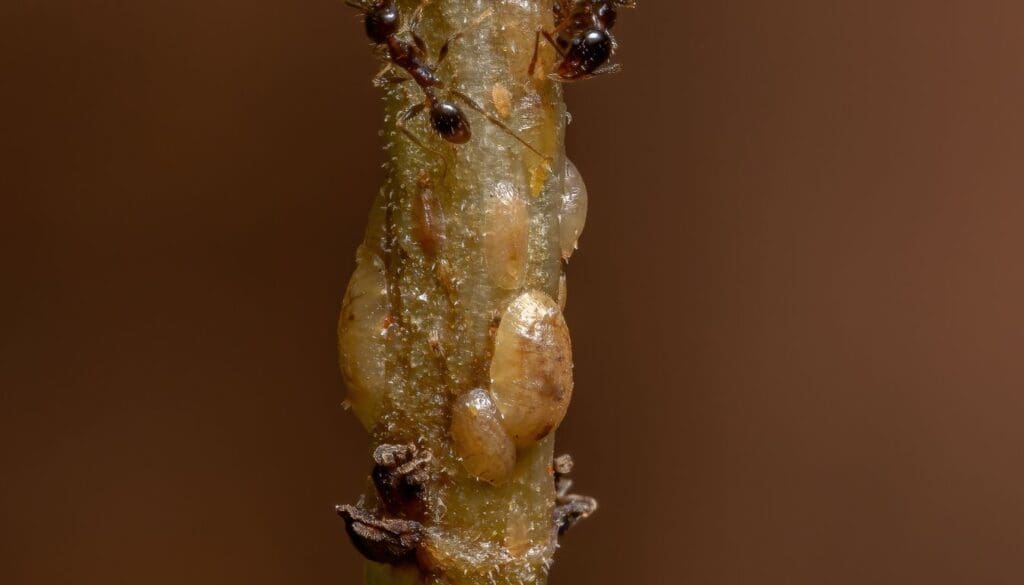
Identifying scale insects in Monsteras is difficult as they attach to leaves without moving.
Scales lay eggs, from which sprawling larvae emerge and travel to new feeding sites.
Signs of scale infestation are:
- Brown bumps under the leaves, stems, and thinner leaf joints
- Yellow spots on the leaves
- Sticky leaves
- Leaves falling off
- Stunted growth
Once you have detected, do the following steps:
- Isolate your Monstera.
- If there are too many scales on any particular plant part, prune off that area.
- If scales have protective armor, manually scrape them off or use tweezers to handpick them.
- Wipe the leaves with a cotton ball dipped in rubbing alcohol.
- Use insecticidal soaps or any DIY horticultural soaps to kill scales.
- Since they can lay too many eggs and hatch quickly, ensure that all the insects are eliminated from your Monstera.
7. Getting rid of Whiteflies from Monstera plants

Whiteflies also suck the sap of the Monstera leaves, excrete honeydew, and cause sooty mold.
Whiteflies damage soft leaves and spread quickly to nearby plants.
Signs your Monstera is infested with whiteflies are:
- Tiny white moth-like bugs flying around the plant
- Sticky residue on the leaves
- Yellowing and deformation on the leaves
- Stunted growth
- To get rid of these uninvited guests from Monstera:
- Use sticky traps to capture the adult whiteflies. It will stop them from residing in the plant and laying eggs.
- Use insecticidal soaps (Natria Insecticidal Soap, Ready-to-Use, 1 Gallon) or neem oil to kill both adults and larvae by suffocation.
- If too many larvae or adults are visible, prune the infected areas or use pesticides to deal with them.
8. Eliminating Leaf Miners from Monstera plants
Leaf miners are tiny, worm-like insects that feed on the interior parts of your Monstera leaves.
One common sign signifying that your Monstera has leaf miners is the squiggly white lines or trails they leave behind as they move from one place to another.
To get rid of the leaf miners, use systemic insecticides.
These get absorbed by the plant.
As the miners burrow into the plant and feed on the foliage, they also consume the insecticide and die.
Keep your Monstera healthy and maintain good ventilation around to prevent leaf miners.
Bug prevention strategies for Monstera plants

Though there are ways to eliminate bugs from your Monsteras, prevention is the best way out.
Let’s look at some preventive strategies to keep pests away from Monsteras:
- Check your Monstera before buying it. Infested plants will have pests despite proper care. Look for yellowing, holes, or pests. Choose a healthy plant.
- Quarantine new plants for 1-2 weeks before adding them with others. It allows early detection and treatment and prevents the spread of bugs or pests.
- Insect eggs might stay in your old pots and soil mixes. So, use clean pots and fresh potting mixes while potting.
- Since most bugs get attracted by moist conditions, avoid overwatering your Monsteras. Let the top few inches dry out before every watering session.
- Use a well-drained potting mix for Monsteras to avoid prolonged wet conditions. Also, ensure your pot has drainage holes to drain the excess water.
- Provide enough bright indirect sunlight to your Monsteras. It will keep the soil dry and the plants healthy. Ensure good air circulation around your plants.
- Despite regular maintenance, daily checks are necessary to prevent pest infestations in Monsteras.
- Spread smelly materials around the pot and create margins, like diatomaceous earth, coffee grounds, chili, pepper, or cayenne powder. These can also keep your pets at bay.
Final thoughts
Monstera plants are sturdy but will be attacked by pests in favorable conditions. Thrips, spider mites, scales, aphids, mealybugs, gnats, whiteflies, and leaf miners cause plant health issues. Isolate, shower, and treat your Monstera with neem oil, horticultural soaps, and insecticidal soaps to eliminate pests. Prune the heavily damaged areas if needed.
Release predatory mites or ladybugs or wipe leaves with rubbing alcohol to kill bugs. Use sticky traps or vinegar solution to trap the flying bugs, like thrips, whiteflies, or gnats. You can even handpick bugs like scales. For heavy infestations, use imidacloprid or pyrethrin-containing insecticides.
Follow the label instructions. Prevent pest infestations to protect your Monstera. If left unchecked, they can kill your plant or spread diseases.
How can I identify pests on Monstera?
To check if your Monstera has bugs, look for yellowing, stunted growth, deformed leaves, bumps, streaks, or spots. Examine your plant closely to identify the pests and determine how to deal with them.
What are the easy natural pest control methods for Monstera?
Use horticultural or insecticidal soaps, neem oil, and sticky traps. Release natural predators like predatory mites and ladybugs, provide adequate sunlight, and clean the leaves regularly.
Reference: Monstera Wikipedia, Plant pests Wikipedia
Recommended Garden Supplies
| Product Image | Our Recommended Gardening Supplies | Check Offers! |
|---|---|---|
Top Top
Top
Top
Top
Top
Top
Top
Top | rePotme Houseplant and Tropical Classic Potting Soil Mix | Check Offer On Amazon |
 Top
Top
Top
Top
Top
Top
Top
Top | Espoma Organic Indoor Plant Food | Check Offer On Amazon |
 Top
Top
Top
Top
Top
Top
Top
Top | GooingTop LED Grow Light 6000K Full Spectrum Clip Plant Growing Lamp | Check Offer On Amazon |
 Top
Top
Top
Top
Top
Top
Top
Top | Soil Moisture Meter | Check Offer On Amazon |
 Top
Top
Top
Top
Top
Top
Top
Top | Govee Hygrometer Thermometer, Bluetooth Enabled! | Check Offer On Amazon |
 Top
Top | LEVOIT Humidifiers for Large Room(Best For Plants) | Check Offer On Amazon |
 Top
Top
Top
Top
Top
Top
Top
Top | Upgraded DIY Automatic Drip Irrigation Kit, 15 Potted Houseplants Support | Check Offer On Amazon |
 Top
Top
Top
Top
Top
Top
Top
Top | Stainless Steel Heavy Duty Gardening Tool Set | Check Offer On Amazon |
 Top
Top
Top
Top
Top
Top
Top
Top | Bonide Insecticidal Soap | Check Offer On Amazon |
 Top
Top
Top
Top
Top
Top
Top
Top | Bonide 32 oz Spray Neem Oil for Organic Gardening | Check Offer On Amazon |
 Top
Top
Top
Top
Top
Top
Top
Top | Garden Safe Fungicide | Check Offer On Amazon |

